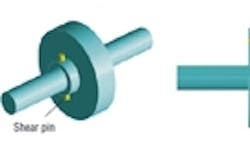For years machine designers have incorporated some type of overload protection into the moving components of their machines. Today, with the cost of machinery increasing directly with evolving technology, the demands for overload protection are higher than ever. Not only do these devices protect expensive mechanisms, they also help minimize downtime. Understanding the principles behind different types of mechanical torque limiters can give you the edge you need to choose the best method for protecting your machinery.
An object in motion...
When the rotating components throughout a drive train suddenly stop, as in a jam, the result -- thanks to the law of inertia -- is a build-up of torque several times higher than normal operating range. More often than not, one or more of the weakest components in the drive train becomes damaged or even breaks.
Latching on
Overload latch mechanisms consist of a latch that mounts to a driving flange or hub and a mating latch block that goes on the driven component. If a jam or overload occurs, the latch disengages -- protecting the output mechanisms.
This type of torque limiter provides positive protection on the output side of the machine and is backlash free. It is self-actuating and the latch re-couples in the same position, thus preserving machine timing. As the latch disengages it can also signal the machine controller of the overload condition and stop the machine.
On the down side, overload latches normally add inertia to the system and take up space for mounting. Also, the adjustable spring portion of the mechanism is sensitive and subject to dirt and contaminants.
Shear genius
One of the earliest torque limiting devices, still in use today, is called a shear pin. The principle behind this mechanism is simple. The pin, typically fabricated from a softer material, inserts through a hub into a drive shaft or directly between two mating flanges. If an overload greater than the pin's shear strength occurs, the pin will break, or shear, releasing and thus protecting the mating components. This arrangement can provide one of the most rigid connections between two rotating elements.
Although the principle is simple and the solution relatively inexpensive, replacement of a sheared pin necessitates downtime and possibly a maintenance mechanic. Torque adjustment is also difficult, and shear pins fatigue over time, often shearing at a lower torque than intended. It's also a common practice to replace the weakened pin with a stronger one possessing a much higher shearing point, which, of course, means no protection at all.
The friction factor
Friction clutches, which are similar to car brakes, link the components of a machine drive train by enveloping a pulley or gear between high-friction linings. During normal operation, a control element and spring combination applies pressure to the friction linings which, in turn, clamp the driven component. During an overload, pressure from the springs is overcome, letting the driven component slip between the linings. This prevents any transmission of torque to the rest of the system. Correcting the overload re-engages the springs as well as torque transmission.
Friction-style torque limiters have little inertia and are easy to adjust. They cannot, however, be supplied with single-positioning features for maintaining machine timing, thus requiring manual realignment of critical components before restarting the system. Further, the slipping torque of a friction device can vary considerably due to environmental conditions such as moisture, heat, and dust.
The detent principle
Detent-type torque limiters use a series of balls, plungers, or rollers held in position – in seats or detents – with spring pressure.
When an overload occurs, the locking elements come up out of their detents. This in turn lets the driving and driven components rotate freely without transmitting torque. It may also actuate a limit switch that stops the entire system.
Although all three detent-type systems are generally effective, using rollers or balls versus plungers eliminates the possibility of fretting corrosion and its related drawbacks including large variations in torque values.
Rolling on
In a roller detent system, spring force holds the rollers firmly in position in specially contoured detent seats. This makes the trip torque fully adjustable even in the installed position. The precision of the contoured seat also ensures zero backlash so there is no reduction in system accuracy.
During normal operation, precision rollers transmit torque through the drive plate to the driven plate. In the event of an overload, the rollers overcome the spring force against them and rise up out of their seats, disengaging the drive. Single positioning can be attained by unevenly spacing the rollers such that it permits only one engagement orientation. This maintains the registration of the connecting shafts and minimizes downtime.
In many instances, a proximity or limit switch senses the movement of a switch plate that travels axially (with the rollers) during tripping. The signal from the switch typically relays into the machine control which, in turn, shuts the machine down safely before damage occurs.
